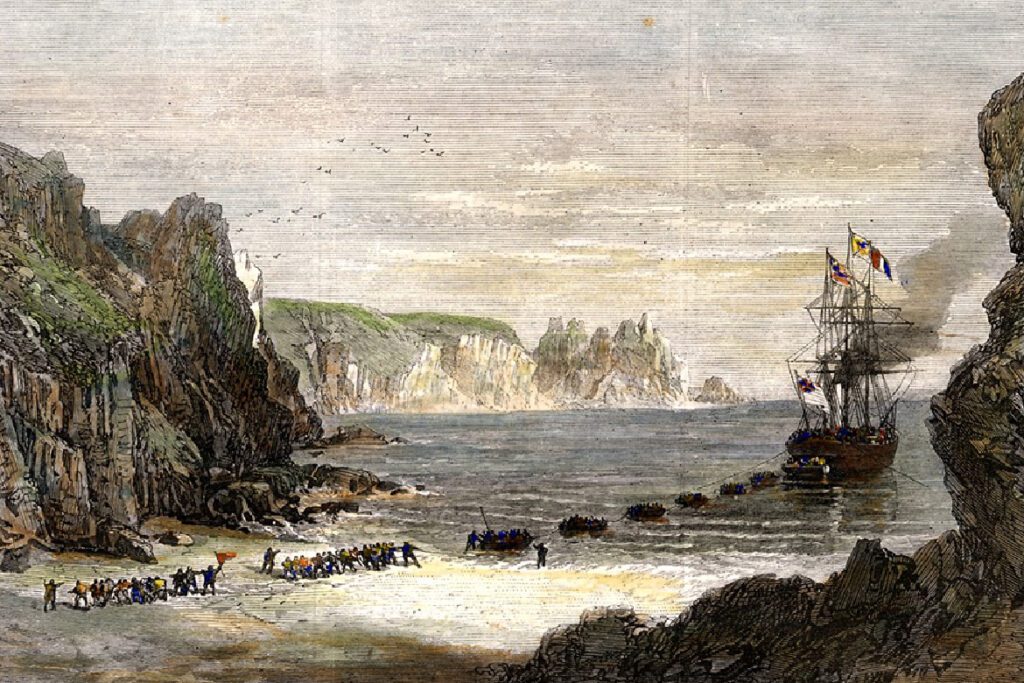Seashells and Empires: allowing memories to guide my curator research
Nestled amongst kelp and Cornish coastline, the ‘Museum of Global Communications’ – Porthcurno – is where I am undertaking the ‘Citizens Curator programme’. As somebody who is invited to assemble the archives material into histories and stories, I thought I might begin with space, and the natural landscape the museum – and the telegraph – occupy.

Sandy coves and oceans carried the cable that connected Britain to India and facilitated connectivity throughout its empire. The archive houses remnants of this marine life through shipping routes, submarine engineering, and maritime paintings (to name a few). And while these things are inspiring, my own experiences of these sea-salted spaces are its rock pools and shells. How might I make connections between these things?
Seashells and Telecommunication

Seashells are also remnants of marine life, the jewels of snails and invertebrates now dead. When I was a child, I would hold a cowry-type shell against my ear to hear the sound of the sea. In popular folklore, this is called seashell resonance, where reverberations in the shell’s cavity sound like crashing waves. Growing up in Nottinghamshire, the sea was far away, but with some creativity, the shell allowed me to reach it at any time – telecommunication.
I began to acknowledge the ways in which childhood memories could inform my approach to curating, making it a creative and reflective exercise, rather than some neutral piece of research. Having the courage to hold onto this idea has led me to some fascinating discoveries. While the humble shell shares a watery affinity with the undersea telegraph, it has a role to play in histories of global communication and exchange too.
The Cowry Shell
The cowry shell was once a widely used form of currency, especially among African natives, who were forming sophisticated, global networks with them for centuries. Currency is embedded in social institutions, practices, and ways of life, and through the technological innovations that enabled colonial projects (like the telegraph), alternative currencies and mediums of exchange were able to circulate and colonise people more forcefully. Indeed, scholars such as Mahir Saul (2004) have argued that cowry shells competed with the Franc in the French colonies of West Africa, where this local currency posed a threat to the commercial expansion of its empire.

Similarly, Harcourt Fuller (2009) has suggested that in Ghana, monetary sovereignty in the form of cowry shells was ousted by a monetary system established by British colonisers. Archaeologists and historians have gone on global journeys to show that ‘cowries’ are one of the few objects enslaved people could take with them, remnants of an old-world for diasporic communities. Finally, Laurie Pearce (1992) extended this and argued that they might have been used to trade within plantation settings. So, there is a great deal of historical work that has been done on shells and their role in colonialism. Telecommunications is ever-present here; I just need to deepen my search in the archive and see what I can find.
My Takeaway
I will keep researching this and talk to friends at PK Porthcurno and the citizen curator programme. However, what I have taken away already is the creative/curative potential of life experiences and memories. When I enter the archive, I am bringing a standpoint, a perspective, and rather than ignore this, I might bring it into the research to show how these histories reassemble themselves through me. While the citizen curator may lack expert knowledge, we can nonetheless bring self-reflection, memories and rich childhood fantasies into our research process. Least of all, when we deliver history in this way, we might appreciate everyday things as artefacts with stories to tell and global connections to make.
Author
This article was researched and written by Jay Hollis.
Jay Hollis is a student from the University of Exeter and a Citizen Curator. He is finding ways to be creative in telling stories through the museum’s archives.
This blog was created as a part of our Digital Takeover Day 2021. To explore more articles from our Young Curators, Citizen Curators & International Volunteers head to our #digitaltakeover NEWS page.
